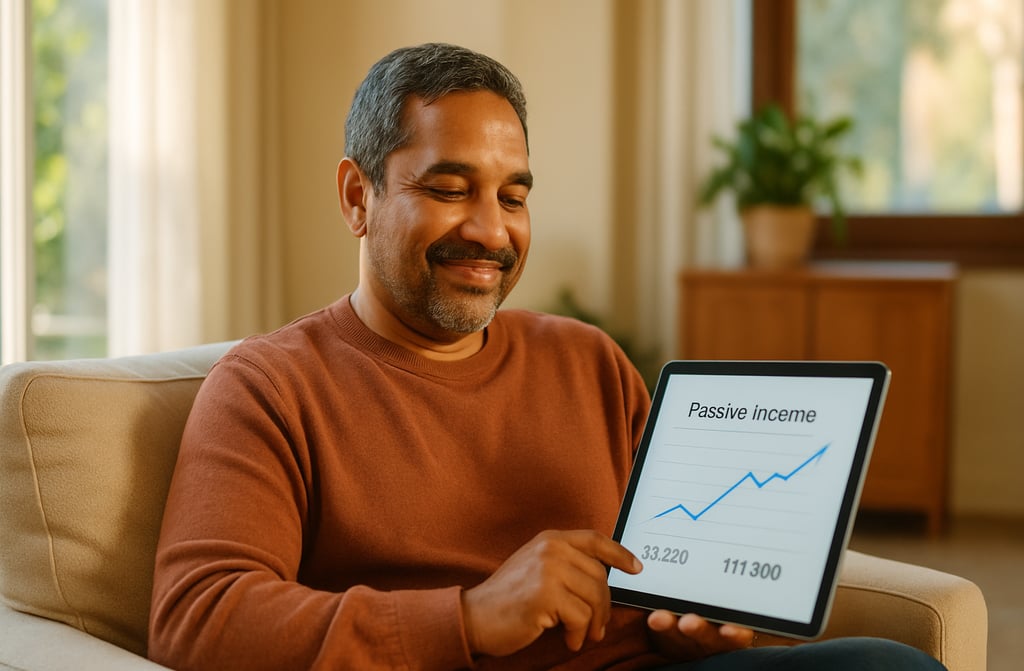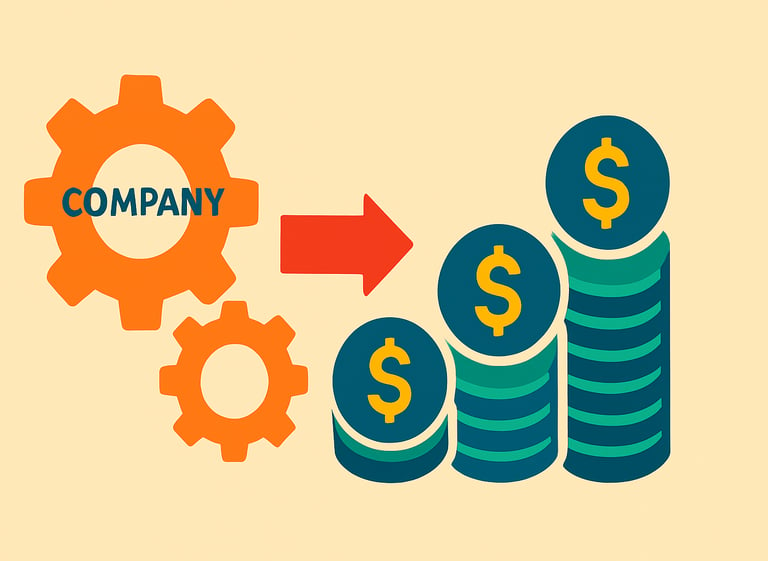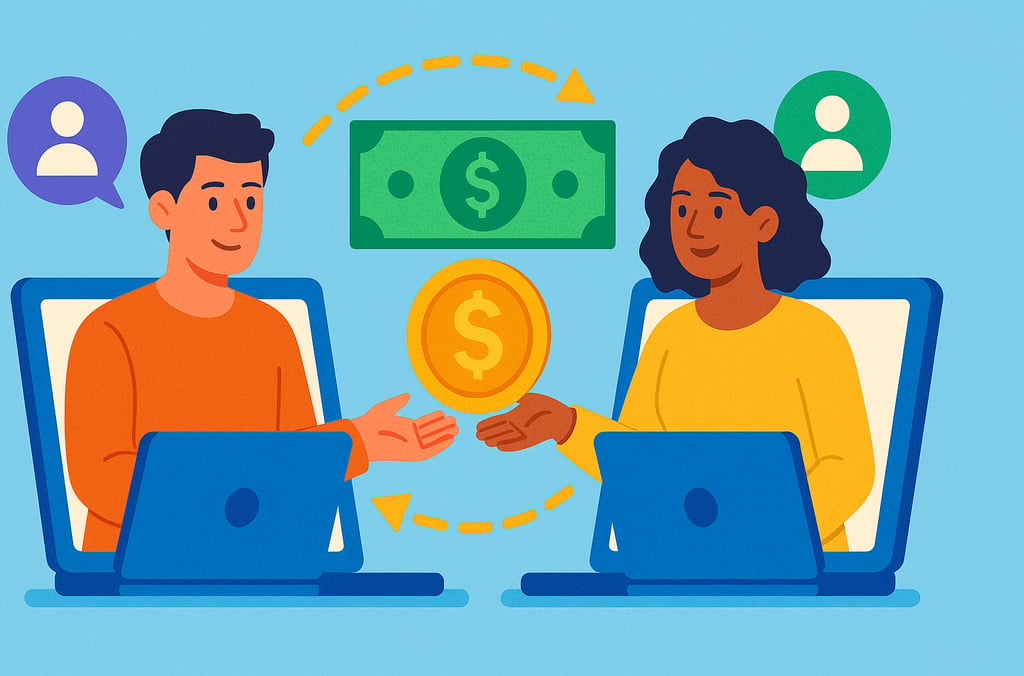Unlock Passive Income: How to Invest $500,000
Want passive income from your $500k? This guide explores investing in real estate, dividend stocks & ETFs, P2P lending, & more. Build steady income streams & financial freedom. Get your $500,000 working for you!
Eddy Enoma
5/18/202515 min read
Turning $500k into Steady Income Streams
Ever felt that nagging feeling? The one that tells you there must be more to life than trading all your hours for a paycheck? You know, the daily rush, the tight deadlines, the constant grind just to keep the bills paid. It’s a feeling many of us know well. We dream of a different way — a way to have more control over our time, more freedom to pursue passions, and less worry about money.
Imagine this: a Tuesday morning, sun streaming in, and you’re sipping coffee, not rushing out the door. Your mind isn’t on traffic or your boss’s mood. Instead, you’re thinking about what book to read or where to take a walk. Meanwhile, behind the scenes, your money is quietly working for you, generating income. That’s the power of Passive Income.
Now, let’s add a significant piece to this picture: $500,000. For many, this is a dream number. Maybe it came from years of hard saving, selling a property, a gift, or successfully building and selling something valuable like an online business. Whatever the source, having half a million dollars opens up incredible possibilities. It’s a serious amount of money, and handled wisely, it can become a powerful engine for creating that life of financial freedom through Passive Income.
Simply having $500,000 isn’t the end goal; it’s the starting line. The real goal is making that money grow and produce ongoing income without you having to work actively for it every day. This needs a smart plan, not just guessing or hoping for the best.
So, how exactly do you take $500,000 and turn it into a steady flow of Passive Income? Let’s break down the different ways you can put this money to work.
What’s Passive Income Anyway? (Simple Talk)
Let’s keep it simple. Passive Income is money you earn that doesn’t require you to trade your time for it regularly.
Think about a regular job — you work hours, you get paid for those hours. That’s active income. If you stop working, the pay stops.
Passive income is different. Think of it like building a system or buying an asset (something you own that has value) that brings in money on its own. Once it’s set up, it keeps generating income with little ongoing effort from you. Examples are things like getting rent from a property you own, earning dividends from stocks, or gaining interest from loans you’ve made.
The goal is to create enough of these passive income streams so you have the financial freedom to choose how you spend your time.
Why Focus on Passive Income? (More Than Just Kicking Back)
Earning money while relaxing sounds great, right? But the benefits of building Passive Income go deeper:
Real Freedom: When your income isn’t tied to your daily work, you get your most valuable asset back: your time. You can travel, pursue hobbies, spend time with loved ones, volunteer, or whatever makes you happy, without asking for permission.
Financial Cushion: Having money come in regularly, even if unexpected things happen like losing a job or facing big bills, provides a huge sense of security and reduces stress. It’s a safety net that keeps paying you.
Faster Wealth Growth: When you earn passive income and reinvest some of it, your money starts making even more money. This is called compounding, and it’s a powerful way to grow wealth faster over time. It’s essential for reaching big financial goals.
Staying Ahead of Costs: The price of things tends to go up over the years (inflation). Income from smart investments can grow over time, helping your buying power keep pace with rising costs.
Building Passive Income with $500,000 means you have the potential to create substantial and life-changing financial freedom. Let’s look at the ways to make that happen.
Putting $500,000 to Work: Your Passive Income Options
$500,000 is a significant amount of capital. It allows you to access investment opportunities that can generate meaningful Passive Income. But it’s super important to spread this money across different types of investments. This is called diversification. It helps lower your overall risk because if one investment area has problems, your others aren’t likely to be affected in the same way.
Here are some of the most popular ways to aim for Passive Income with $500,000:
1. Real Estate Investments: From Landlords to REITs
Real estate has traditionally been a go-to for generating Passive Income. With $500,000, you have several ways to get involved:
Buying Rental Properties: This classic method involves buying physical property (like a house, condo, or small apartment building) and renting it out to tenants. The money you collect in rent, after paying for expenses like mortgage, taxes, insurance, and repairs, is your Passive Income.
Practical Illustration: Let’s say you use $200,000 of your $500k as a down payment on a $400,000 property. The rent is $1,800 per month. Your monthly costs for mortgage, insurance, and property taxes are $1,000. You set aside another $300 for repairs and unexpected issues. That leaves you with $500 in monthly Passive Income from this one property. Owning a few properties can really add up.
Pros: Potential for steady monthly income, plus the property’s value might go up over time. You have direct control over the asset.
Cons: Can require work (dealing with tenants, maintenance). Property values can also go down. Finding properties with good cash flow can be challenging, depending on location and market conditions, as reflected in recent rental property market trends and cap rate data across U.S. regions.
Sell Your Online Business Within 60 Days
Get the best price for your business — we take care of the rest.
Real Estate Investment Trusts (REITs): If you like the idea of real estate but don’t want the hassle of being a landlord, REITs are a great option. Think of a REIT as a company that owns, operates, or finances income-producing real estate, like shopping malls, office buildings, hotels, or apartment complexes. You can buy shares in these companies, much like buying stock.
The cool part? REITs are required by law to pay out at least 90% of their taxable income to shareholders each year, often as dividends. This gives you Passive Income from real estate without the headaches of physical property management.
Pros: Easy to buy and sell (they trade on stock exchanges), automatic diversification across many properties, professionally managed, and provides regular income.
Cons: Their value can be affected by both the real estate market and the stock market. You don’t get to choose the specific properties they invest in.
Interesting Fact: There are REITs for almost every type of property you can imagine, including timberlands and infrastructure like fiber optic cables!
Real Estate Crowdfunding Platforms: These online platforms allow many investors to pool their money together to invest in larger real estate projects or properties that might be too expensive for one person.
Pros: Lower minimum investment amounts compared to buying property directly, can diversify across various projects, and is handled online.
Cons: Investments can be less easy to sell quickly (illiquid). Success depends on the specific project and the platform managing it. There are risks like project delays or failure.
2. Dividend Stocks and ETFs: Getting Paid Just for Owning
Owning stock means you own a tiny piece of a company. When profitable companies make money, they sometimes share a bit of that profit with their shareholders. These payouts are called dividends and are a fantastic source of Passive Income.
Dividend Stocks: You can buy shares of individual companies that regularly pay dividends. Look for companies with a history of steady earnings and that pay out those profits consistently.
Practical Illustration: If you invest $100,000 of your $500k into a mix of solid companies that collectively pay an average 3.5% annual dividend yield, you would receive about $3,500 per year in Passive Income. This is typically paid out quarterly. If the companies increase their dividends over time (a good sign!), your passive income grows.
How to Select: Don’t just chase the highest dividend percentage — sometimes that signals a company in trouble. Look for companies that have consistently paid and increased their dividends over many years (often called “Dividend Aristocrats”). Check how much of their earnings they pay out (the payout ratio) — a lower percentage is safer, meaning they can afford the dividend and have money left to grow. Avoid companies buried in debt.
Pros: Potential for the stock value to increase over time, and you get regular income. Reinvesting dividends means buying more shares, which leads to even more dividends later (compounding power!).
Cons: Stock prices can go down. A company might reduce or stop paying dividends if it hits hard times.
Current Trend: The average dividend yield for large U.S. companies (like those in the S&P 500 index) has generally been lower in recent years compared to historical averages, sometimes around 1.3% to 1.5%, as shown in the S&P 500 Dividend Yield data.
Dividend ETFs: A simple way to invest in many dividend-paying stocks at once is through a dividend-focused ETF (Exchange-Traded Fund). These are like baskets holding shares of many different companies known for paying dividends.
Pros: Instant diversification across lots of stocks and industries, helping reduce risk compared to picking just a few. They are managed by professionals and are easy to buy and sell. Provides more stable income than relying on one or two stocks.
Cons: You get the average performance and dividend yield of the stocks in the basket. You don’t have control over the individual stocks.
Sell Your Online Business Within 60 Days
Get the best price for your business — we take care of the rest.
3. Fixed-Income Securities: The Stability Crew
With fixed-income investments, you’re lending money and getting paid back with interest. They are generally considered less risky than stocks or real estate, but usually offer lower potential returns. They can be a good way to add stability to your Passive Income portfolio.
Bonds: When you buy a bond, you lend money to the bond issuer (could be the government or a company). They promise to pay you back the original amount on a specific date (maturity date) and pay you interest payments regularly along the way (often every six months).
Bond Ladders: A smart strategy to create regular income with bonds. Instead of buying one bond that matures far in the future, you buy several bonds that mature at different, staggered times (like every year for the next 5–10 years). As one bond matures, you can use that money to buy a new, longer-term bond, creating a steady flow of income and allowing you to take advantage of changing interest rates over time.
Pros: Provides predictable income through interest payments. Generally considered safer than stocks. You get your original money back when the bond matures (assuming the issuer doesn’t default).
Cons: Returns are often lower than from stocks. If interest rates rise after you buy a bond, your bond’s fixed interest rate might be less attractive.
Treasury Securities: These are bonds issued by the U.S. government. They are considered among the safest investments you can make, as they are backed by the full faith and credit of the U.S. government.
Types: Treasury Bills (short-term), Treasury Notes (medium-term, pay interest every six months), and Treasury Bonds (long-term, also pay interest every six months).
Pros: Extremely low risk of default! Provides reliable Passive Income (for notes and bonds). Interest earned is free from state and local income taxes.
Cons: Because they are so safe, the returns are typically lower than other investments. However, you can purchase Treasury securities directly from the U.S. government through TreasuryDirect.gov, which offers a secure platform for buying and managing these investments.
4. Business Ventures: Investing in Enterprise
This category is a bit broader and can involve more hands-on effort initially, but can build into powerful Passive Income streams.
Investing in Small Businesses or Startups: You could invest money directly into a promising small business or a new startup company. This can be done by getting a piece of ownership (equity) or by lending them money (debt).
Practical Illustration: You could invest $50,000 in a promising local coffee shop expansion in exchange for a percentage of its future profits. If the business grows and becomes very profitable, that percentage could pay you significant Passive Income. Or, you could provide a loan to a business and get regular principal and interest payments back.
Pros: Potential for high returns if the business succeeds. It can be personally rewarding to help a business grow.
Cons: High risk of losing your investment, especially with startups. Investments can be hard to sell quickly if you need the money. Requires careful research (“due diligence”) into the business, their plan, and the team running it.
Sometimes, the smart move isn’t just investing in someone else’s business, but recognizing the value in one you might have built yourself. If you’ve put in the work to create a successful online business, turning that asset into capital can fund your next Passive Income ventures. Exploring options to sell your online business and get a good valuation is a practical step in this direction. You can find out more here.
Franchise Ownership: Buying into a franchise means you buy the rights to open and run a business using an established brand (like a popular restaurant or service). The main company (the franchisor) provides training, systems, and marketing support.
Pros: You get a proven business model and a recognized brand, which often leads to higher success rates than starting from scratch. Support from the franchisor can make running the business easier.
Cons: Can have a high initial cost (franchise fees). You usually have to pay ongoing fees (royalties) to the franchisor. You have to follow the franchisor’s rules, which limit your flexibility. It might require more active management than truly “passive” investments, especially early on.
5. Peer-to-Peer (P2P) Lending: Becoming a Mini-Lender
Peer-to-peer (P2P) lending lets you lend money directly to individuals or businesses online, bypassing traditional banks. You earn Passive Income from the interest they pay back.
How It Works: You sign up on a P2P lending platform. Borrowers apply for loans through the platform, which checks their creditworthiness and assigns a risk level. You browse the loan listings and choose which ones you want to fund (you can put small amounts into many different loans to spread risk). The platform handles collecting payments from the borrowers and sends your share of the principal and interest back to your account. This creates a stream of Passive Income. Many platforms are available; for example, you might explore platforms like Lendermarket.
Pros: Potential for higher returns compared to savings accounts or CDs. Can diversify across many loans. Once you’ve selected loans (or set up automatic investing), it’s relatively hands-off.
Cons: Risk of borrower default (they don’t pay back). P2P investments are not government-insured like bank deposits. Platforms charge fees. While platforms use tools to assess risk, the risk of losing your investment is real.
Current Trend: The P2P lending market continues to grow globally, with technology playing a significant role in enhancing accessibility and risk assessment. Average returns can vary widely depending on the platform and the risk level of the loans you choose, but some platforms report average returns in the double digits. For instance, the 4thWay P2P and Direct Lending Index indicates that P2P lending has returned an average of 7.36% per annum over the past decade, outperforming traditional investments like the FTSE 100.
6. High-Interest Savings Accounts and CDs: Safety First
These options won’t make you a millionaire fast, but they are incredibly safe places for some of your money, especially funds you might need access to relatively soon or simply want protected while earning some Passive Income.
High-Interest Savings Accounts: These are bank accounts that pay a much higher interest rate than standard savings accounts. Your money is easily accessible when you need it.
Current Trend: Thanks to changes in interest rates by the Federal Reserve, many online banks are currently offering very competitive rates on high-yield savings accounts, often significantly higher than traditional banks with physical branches. Some rates are well over 4% APY (Annual Percentage Yield). For a comprehensive comparison of current high-yield savings account rates, you can refer to NerdWallet’s list of the best high-yield online savings accounts.
Pros: Very safe — typically FDIC insured up to $250,000 per depositor, per bank. Money is easily available. Earns Passive Income through interest.
Cons: Returns are generally lower than investments like stocks or real estate over the long term. Interest rates can change.
Certificates of Deposit (CDs): With a CD, you agree to leave your money in the bank for a fixed period (the term, from a few months to several years) and in return, you get a fixed interest rate for that entire term.
Pros: Predictable Passive Income because the interest rate is fixed. Safe — also typically FDIC or NCUA insured.
Cons: Your money is locked up for the term. If you take it out early, you’ll likely pay a penalty, which reduces your earnings. Returns are usually modest compared to riskier investments.
7. Alternative Investments: Exploring Other Avenues
With $500,000, you have the flexibility to consider investments outside the usual categories. These often come with higher risk and can be harder to sell quickly, but offer potential for unique returns and diversification.
Art, Wine, and Collectibles: Investing in physical assets like fine art, rare wines, classic cars, or other high-value collectibles. Their value might increase over time.
Pros: Can be enjoyable to own. Potential for significant appreciation in value. Can offer diversification away from traditional markets.
Cons: Can be very hard to sell quickly (illiquid). Requires expertise to buy wisely. Need secure storage and insurance, which costs money. Value can be subjective and tied to trends.
Interesting Fact: The market for collectibles like classic cars or rare stamps can sometimes perform very differently from the stock market.
Cryptocurrency Staking: If you understand and are comfortable with cryptocurrency, staking is a way to earn Passive Income from certain types of crypto. It involves holding your cryptocurrency in a special wallet to help the network function and earn rewards in return.
Pros: Can earn a yield on your crypto holdings. Relatively hands-off once set up.
Cons: Cryptocurrency values can be extremely volatile and can drop sharply. Your staked coins may be locked up for a period. Not insured by governments.
Building Your Passive Income Plan: How to Mix and Match
Okay, you’ve seen the different ingredients for building Passive Income. Now, how do you combine them?
1. Figure Out Your Risk Comfort Level: This is the most important step. How much uncertainty can you handle?
Are you cautious? Lean more towards safer options like Treasury bonds, CDs, high-yield savings, and maybe diversified dividend ETFs.
Are you comfortable with more risk for potentially higher rewards? You might put a larger percentage into rental properties, individual dividend stocks, P2P lending, or maybe a small part in alternative investments.
There’s no single “right” mix for $500,000 — it’s about what helps you sleep at night while working toward your goals.
2. Diversify Your Money: Seriously, don’t put all $500,000 into just one idea. Spread it across different types of investments. If one area struggles, others can help pick up the slack. A good mix might include some real estate, some stocks, some bonds, and some cash in a high-yield savings account.
3. Align with Your Goals: When do you need the income? If you need money now, focus on investments that pay out regularly. If your goal is long-term growth for retirement many years away, you might focus more on investments with higher growth potential and reinvest the income.
4. Do Your Homework (Always!): For any investment you consider, take the time to understand exactly how it works, what the real risks are, and how it makes money (or loses money). Don’t invest in something just because someone else is doing it. Consider talking to a financial advisor who is legally required to act in your best interest (a fiduciary).
5. Be Patient and Review: Building substantial Passive Income takes time, even with $500,000. Market values will go up and down. Stay focused on your long-term plan. Check your investments regularly (maybe every 6–12 months) to make sure they are still meeting your needs and that your mix of investments is still right for your goals and risk tolerance. You might need to adjust things over time — this is called rebalancing.
Sell Your Online Business Within 60 Days
Get the best price for your business — we take care of the rest.
Conclusion: Your Path to Financial Freedom
Having $500,000 is an incredible opportunity to build a life with more freedom and security through Passive Income. It’s not about finding one secret investment, but about building a smart, diversified portfolio using the different tools available.
Whether you choose to invest in real estate, get paid dividends from companies, earn interest from lending, explore business opportunities, or use high-yield savings for safety, the key is to create a mix that fits your comfort level and helps you reach your financial dreams.
Start by understanding your options, make a plan that feels right for you, and take action. With smart choices, consistent effort, and patience, that $500,000 can indeed become the engine that generates significant Passive Income and helps you live life on your own terms.
Sign Up for More Passive Income Wisdom!
👉 Get exclusive weekly tips on mastering Passive Income strategies and building lasting financial freedom. Learn smart ways to make your money work for you and grow your wealth. Sign up for our newsletter using the form below to get these valuable insights delivered straight to your inbox!
Subscribe for Exclusive Tips & Updates. Enter Your Email Below!



Get the latest strategies on content creation, freelancing, and affiliate marketing, plus passive income straight to your inbox!
🔒 We respect your privacy. Your email is safe with us. Unsubscribe anytime.
Address
Sporerweg 16
94234 Viechtach, Germany
Contacts Us
(049) 170 499 6273
Subscribe to our newsletter
© 2026 Onlinebizoffers. All rights reserved.




















